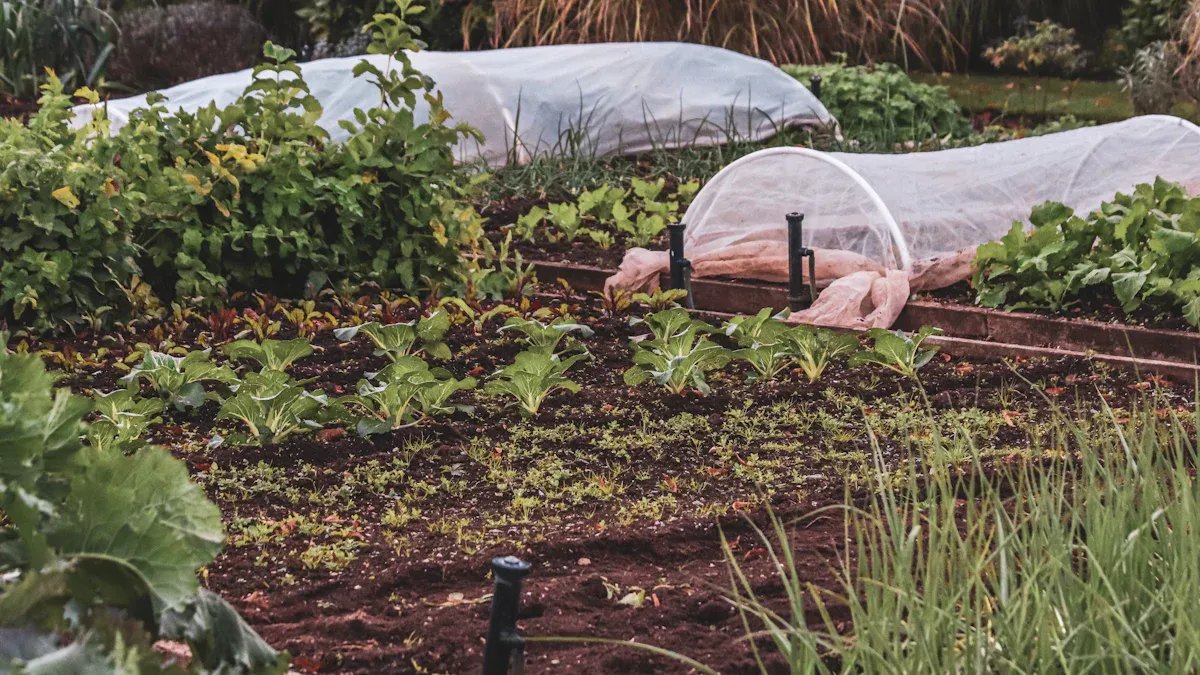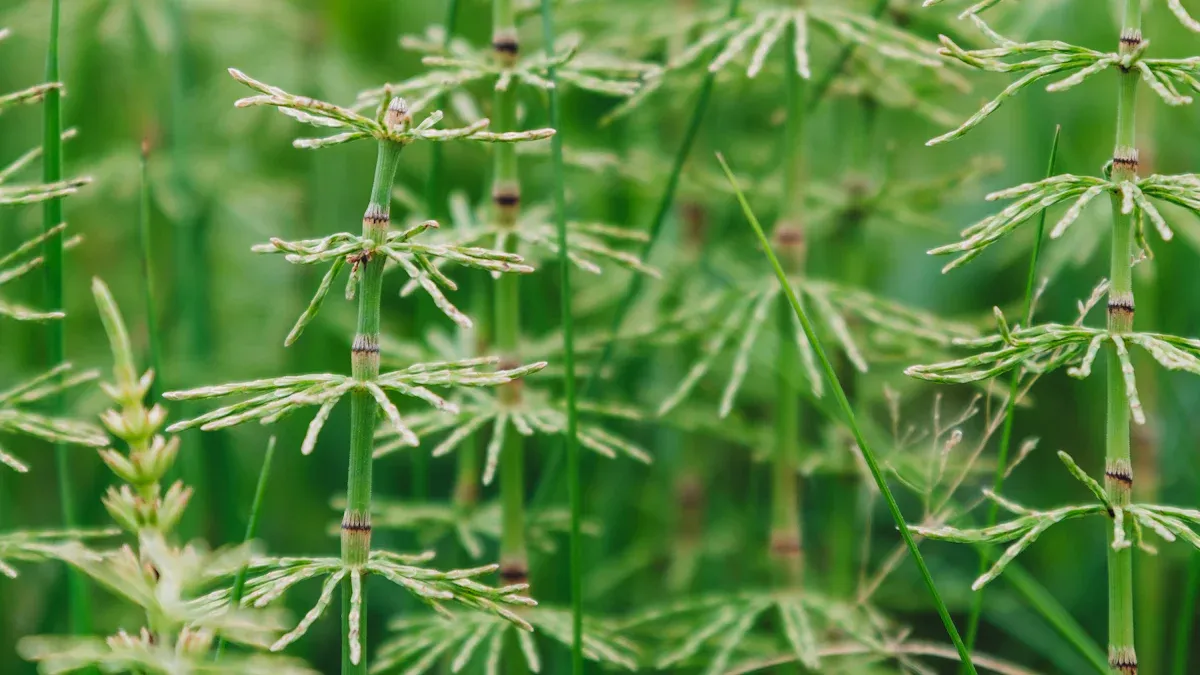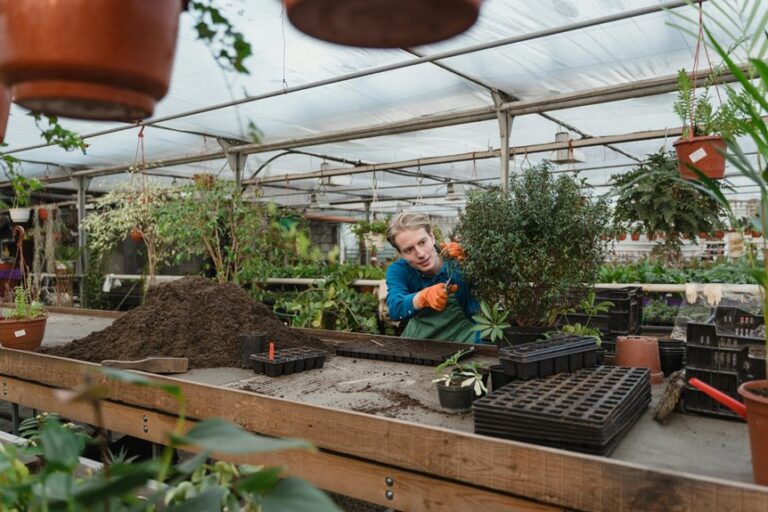
Fertilizing your horsetail plant is crucial for its growth and overall health. Proper fertilization helps boost its vitality, especially if you notice your plant struggling. Many gardeners often wonder about the best types of fertilizers to use. Here are some common concerns you might face:
Horsetail plants don’t need overly rich soil, so fertilization might not always be necessary.
If your horsetail is having a tough time, slow-release plant food can give it the extra support it needs.
Maintaining consistent soil moisture and addressing any nutritional deficiencies during the growing season can really help.
By understanding these points, you can make informed decisions that will enhance your plant’s growth.
Key Takeaways
Understand that horsetail plants thrive in moist environments and require minimal fertilization. Use slow-release fertilizers if your plant shows signs of struggle.
Silicon is essential for horsetail growth. Ensure your plant receives this nutrient along with a balanced mix of others for optimal health.
Timing is crucial for fertilization. Apply balanced fertilizers in early spring and consider additional feeding during the growing season for best results.
Avoid over-fertilization, which can harm your horsetail. Less is often more; monitor your plant for signs of nutrient imbalance.
Choose organic fertilizers to support both your horsetail and the environment. They improve soil health and provide steady nutrient release.
Understanding Horsetail Needs

Nutritional Requirements
To help your horsetail thrive, you need to understand its nutritional needs. Horsetail, or equisetum, primarily requires silicon, which plays a vital role in its growth. Here’s a quick look at how silicon benefits your plant:
Nutrient | Role in Plant Growth |
|---|---|
Silicon | Increases growth, improves yield and quality, enhances photosynthesis, aids nitrogen fixation, and provides stress tolerance |
While silicon is crucial, horsetail also benefits from other nutrients. A balanced approach ensures your plant gets what it needs without overwhelming it.
Environmental Factors
Environmental conditions significantly impact the health and growth rates of your horsetail. Here are some key factors to consider:
Moisture availability is crucial as horsetail thrives in consistently moist environments.
The optimal temperature range for growth is between 15°C to 20°C (59°F to 68°F).
Soil quality and nutrient levels significantly influence growth rates.
When planting horsetail, remember that it prefers wet soil. This water-loving plant does well in full sun but can also adapt to partial shade. The soil should ideally be sandy or gravelly, with a pH ranging from 4.0 to 7.0. This adaptability allows horsetail to grow in various conditions, but it flourishes best in acidic, poorly drained soils.
By paying attention to these nutritional and environmental factors, you can create the perfect conditions for your horsetail to grow strong and healthy.
Fertilizing Your Horsetail Plant: Types of Fertilizers

When it comes to fertilizing your horsetail plant, you have two main options: organic and synthetic fertilizers. Each type has its pros and cons, so let’s break them down.
Organic vs. Synthetic
Organic fertilizers come from natural sources, like plant or animal matter. They release nutrients slowly, which is great for your horsetail because it allows for steady absorption. Here’s a quick comparison of the two types:
Feature | Organic fertilizers | Synthetic fertilizers |
|---|---|---|
Nutrient concentration | Lower concentrations, thus greater amounts must be used | Higher concentrations, thus smaller amounts can be used |
Nutrient release rate | The rate of nutrient release is optimal for plant uptake | Nutrients are rapidly released in quantities that may be excessive for plant uptake |
Safety for plants | Relatively risk-free; root burns are extremely seldom | High risk of burning plant roots or leaves due to high salt content |
Effects on soil | Help keep the soil healthy by adding organic matter | Can degrade soil microbiology and chemical structure over time |
Environmental Safety | Minimal risk of environmental pollution | High risk of leaching and greenhouse gas emissions |
Using organic fertilizers not only supports your horsetail but also benefits the environment. They improve soil health by enhancing soil structure, water retention, and nutrient availability. On the other hand, synthetic fertilizers can lead to nutrient imbalances and even contribute to water pollution if used excessively.
Recommended Fertilizer Types
Now that you know the differences, let’s look at some recommended fertilizers for your horsetail plant:
Balanced, slow-release fertilizer (e.g., 10-10-10): This type provides essential nutrients like nitrogen, phosphorus, and potassium. Apply it in early spring around the base of the plant, but avoid direct contact with the stems.
Container Plants: If you’re growing horsetail in pots, consider using diluted liquid fertilizer every 4-6 weeks during the growing season. Organic alternatives like compost tea or fish emulsion work well too.
By choosing the right fertilizer type, you can ensure your horsetail plant gets the nutrients it needs for optimal growth. Remember, the key is to maintain a balance that supports both your plant and the environment.
Timing and Frequency for Fertilizing
Seasonal Considerations
Timing is everything when it comes to fertilizing your horsetail plant. You want to align your fertilization efforts with the seasons to maximize growth. Here’s a quick guide to help you out:
Spring: This is the best time to start fertilizing. As the weather warms up, your horsetail begins to wake up from dormancy. Apply a balanced fertilizer around early spring to give it a nutrient boost. This helps kickstart its growth after the winter months.
Summer: During the growing season, your horsetail will benefit from additional nutrients. If you notice slower growth, consider applying a slow-release fertilizer in early summer. This will provide a steady supply of nutrients as the plant continues to grow.
Fall: As temperatures drop, your horsetail will start to slow down. You can reduce or even stop fertilizing during this time. The plant will focus on storing energy for the winter, so it doesn’t need as many nutrients.
Winter: Generally, you should avoid fertilizing in winter. Your horsetail is dormant, and adding fertilizer can lead to nutrient buildup in the soil, which can harm the plant when it wakes up in spring.
Growth Stages
Understanding the growth stages of your horsetail is crucial for effective fertilization. Each stage has different needs, and timing your fertilizer application accordingly can make a big difference.
Early Growth Stage: When your horsetail first starts to sprout in spring, it needs a good amount of nutrients. This is the time to apply a balanced fertilizer to support its initial growth.
Active Growth Stage: As your horsetail reaches its peak growth in late spring and summer, it will require more nutrients. You can switch to a slow-release fertilizer during this stage to ensure it gets a steady supply of nutrients over time.
Mature Stage: Once your horsetail is fully grown, it doesn’t need as much fertilizer. You can cut back on feeding during this stage. Just monitor the plant for any signs of nutrient deficiency, like yellowing stems or stunted growth.
Dormant Stage: In fall and winter, your horsetail will enter dormancy. At this point, you should stop fertilizing altogether. This allows the plant to conserve energy and prepare for the next growing season.
By paying attention to seasonal changes and the growth stages of your horsetail, you can optimize your fertilization schedule. This will help ensure that your plant remains healthy and vibrant throughout the year.
Application Methods for Fertilizers
When it comes to applying fertilizers to your horsetail plant, you have a couple of effective methods to choose from. Each method has its benefits, so let’s dive into the details.
Soil Application Techniques
Soil application is one of the most common ways to fertilize your horsetail. Here are some techniques you can use:
Broadcasting: This method involves spreading fertilizer evenly over the soil surface. While it’s easy to do, be cautious. Broadcasting can lead to nutrient runoff and leaching, which may harm the environment.
Placement: Instead of broadcasting, you can apply fertilizer directly near the plant rows. This technique reduces leaching compared to broadcasting, ensuring that more nutrients reach your horsetail.
Fertigation: If you’re using an irrigation system, consider fertigation. This method mixes fertilizer with water, delivering nutrients directly to the roots. It helps control nitrogen leaching and minimizes toxic runoff.
Here’s a quick look at how these methods impact nutrient leaching and sustainability:
Application Method | Description | Impact on Nutrient Leaching and Sustainability |
|---|---|---|
Broadcasting | Uniformly distributes fertilizer over the field | Can lead to high nutrient runoff and leaching |
Foliar | Applies liquid fertilizer directly to leaves | May reduce soil leaching but can still contribute to runoff |
Placement | Applies fertilizer near plant rows | Reduces leaching compared to broadcasting |
Fertigation | Adds fertilizer to irrigation water | Controls nitrogen leaching and reduces toxic runoff |
Liquid Fertilizer Application
Liquid fertilizers can be a great option for your horsetail, especially if you want to provide quick nutrient absorption. Here’s how to apply them effectively:
Dilution: Always dilute liquid fertilizers according to the manufacturer’s instructions. This prevents root burn and ensures your horsetail gets the right amount of nutrients.
Timing: Apply liquid fertilizers during the active growth stage, typically in late spring and summer. This timing maximizes nutrient uptake when your horsetail needs it most.
Foliar Feeding: You can also spray liquid fertilizer directly onto the leaves. This method allows for rapid absorption. Just make sure to do it in the early morning or late afternoon to avoid leaf burn from the sun.
By using these application methods, you can ensure your horsetail plant receives the nutrients it needs for optimal growth while minimizing environmental impact.
Common Mistakes in Horsetail Care Tips
Over-fertilization
One of the biggest mistakes you can make in horsetail care is over-fertilizing. While it might seem like more nutrients equal better growth, that’s not always the case. Over-fertilization can lead to rapid and spindly growth, bright yellow leaves, and even wilted or burned foliage. Long-term effects can be even worse. Excess nitrogen can create nutrient imbalances, making it hard for your horsetail to absorb other essential nutrients like potassium and phosphorus. This weakens your plant, leaving it vulnerable to diseases and pests. In severe cases, it can even cause toxic damage to the roots. So, remember, less is often more when it comes to fertilizing your horsetail.
Ignoring Soil Health
Another common mistake is ignoring soil health. Healthy soil is the foundation for strong horsetail growth. You should focus on maintaining the right conditions for your plant. Horsetail prefers soil low in calcium, so consider amending it with oyster shell or crushed eggshells to improve calcium levels. Here are some effective soil amendments to keep in mind:
Maintain constant moisture with deep watering practices.
Use horsetail as a chop-and-drop method to enhance soil health, but make sure it’s dried before application.
To further improve soil conditions, you can follow these steps:
Apply dolomite lime to adjust soil pH.
Water the area to help dissolve the lime.
After two weeks, add a 2-inch layer of compost or manure to promote earthworm activity, which helps aerate the soil.
By paying attention to these common mistakes, you can ensure your horsetail thrives and grows strong.
In summary, proper fertilization practices are essential for your horsetail plant’s health and growth. Remember to choose the right type of fertilizer, apply it at the right time, and use effective methods. Experiment with these techniques and observe how your horsetail responds. You might be surprised by the results! Happy gardening!
FAQ
What is the best way to fertilize horsetail plants?
You should use a balanced, slow-release fertilizer in early spring. This timing helps your horsetail get the nutrients it needs as it wakes up from dormancy.
How often should I fertilize my horsetail?
Fertilize your horsetail every 4-6 weeks during the growing season. Adjust based on the plant’s growth stage and environmental conditions.
Can I use organic fertilizers for horsetail?
Absolutely! Organic fertilizers are great for horsetail. They release nutrients slowly and improve soil health, making them an excellent choice for your plant.
How to propagate horsetail effectively?
To propagate horsetail, you can divide the rhizomes in spring or fall. Ensure each division has roots and healthy shoots for successful propagation.
What are some planting tips for horsetail?
When planting horsetail, choose a moist, acidic soil with good drainage. Ensure it gets plenty of sunlight and maintain consistent moisture for optimal growth.


